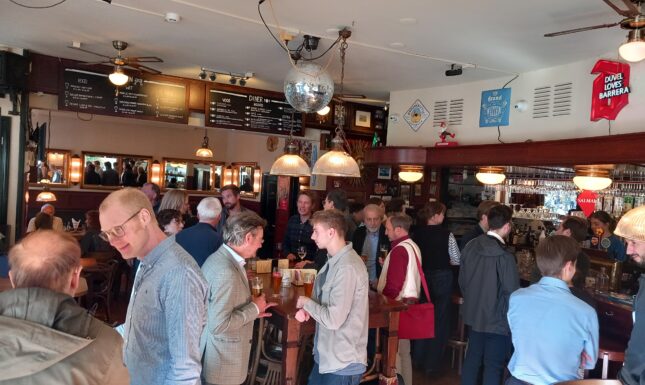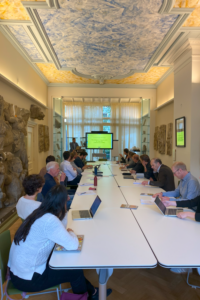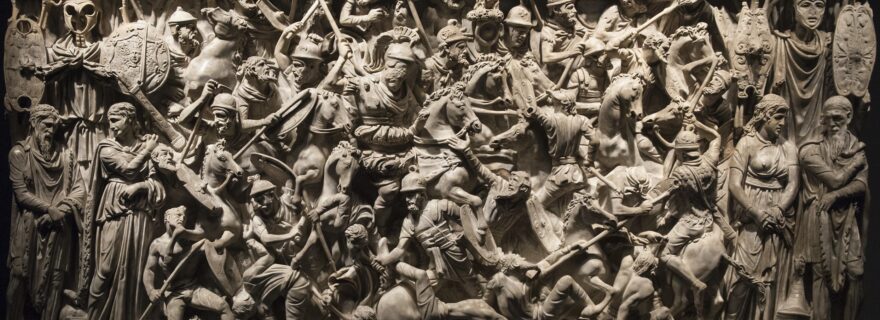Archaeology meets Economy
Purpose: building bridges
On 13 September 2024 a meeting was held in the Rijksmuseum van Oudheden. This one-day workshop aimed to critique and add to the exciting work presented in an important draft paper of Prof. Coen Teulings, Prof. Bas van Bavel and Dr. Bram van Besouw. The authors’ multidisciplinary approach called for bringing together experts from various Social Sciences and Humanities disciplines to discuss this ambitious and valuable paper. To that end, the authors presented their work. Subsequently, expert respondents from various archaeological and anthropological backgrounds provided in-depth reactions. Panel discussions with the broader audience followed. Later on, the discussion continued with drinks.


This paper’s scope was large, with topics ranging from political centralisation and violence to agriculture and social inequalities. Discussing such themes was indeed an exercise in transdisciplinary dialogue. This exercise proved effective in bridging gaps between disciplines and translating findings, methodologies and perspectives across different fields.
Too rarely do archaeologists and economists meet to find common ground, exchange data and learn from each other's work. This workshop aimed to promote such crucial conversation and fruitful collaboration.
Background: an interdisciplinary paper
The paper, titled ‘The Emergence of Government as Organized Violence-cum-Robbery’, discusses the ‘protracted emergence of hierarchical government’ by exploring the shift from so-called ‘tribes’ to ‘chiefdoms’. For this, the authors developed a game-theoretic model.
In most locations with an early ‘Neolithic Revolution’, larger, complex and hierarchical societies arose five millennia after the introduction of agriculture. Yet, the authors argue that the emergence of agriculture is not in itself a sufficient explanation for the move towards sociopolitical hierarchies with large material inequality. A combination of factors, overlapping and intersecting with farming, was vital. These include the kinds of crops cultivated (notably grains vs. tubers), technological innovations (bronze weaponry) and population growth. Moreover, the authors conclude that the formation of states was a nonlinear development rather than a straightforward outcome of neolithisation – albeit one with (independent) recurrency in different periods and regions across the globe. Additionally, they conclude that monopolisation of information was key in facilitating the kinds of coercion and coordination which complex and large-scale states need. Finally, they conclude that, historically, this development towards more hierarchical forms of government was not a net positive for most people and that resistance to statehood was not uncommon.
Rather than sticking with a conventional study of textual evidence, the authors expanded their data pool and analytical scope to include archaeological, anthropological and ethnographic information and theories in addition to economic and historical ones.


Motivation: what can we learn from each other?
What can archaeologists take away from economists? Many archaeologists talk about economies, yet few talk about economics. That is, archaeologists often study production, exchange, consumption, and other forms of human behaviour broadly defined as ‘economic’. Yet few seriously engage with economic theory to understand such topics. This is odd since economists and archaeologists are both interested in understanding human action and interaction embedded in social and physical environments.
What can economists, in turn, learn from archaeologists? When studying the deep human past, obviously, sticking with archival research isn’t enough. Artefacts are relevant in ways often not appreciated by scholars less familiar with material culture studies. The implications of material things on human experience and behaviour are understudied yet profound. Artefacts are more than proxies for reconstructing action and identity. Objects, in and of themselves, matter; their material properties, social meanings, functional affordances and constraints are all of major consequence. Material culture needs to be studied more, but its significance must also be communicated better.
How did this come together during our workshop? On the one hand, this paper had vital historical, archaeological, and anthropological components as it touched on several central debates in these fields. Therefore, archaeologists and others could add crucial insights by informing economists and historians about the material world in which people lived. The physical realities of geographic environments and material culture often play an underappreciated yet profound role in affecting human perception, action, choice and relationships. Archaeology, therefore, adds a crucial dimension to this paper. The organisers of this workshop strongly believe that the current ‘material turn’ should not be confined to archaeology but must inform all studies of the human past and present.
On the other hand, economic theory and economic history are at the core of the authors’ study. As such, their approach and interpretations can add to archaeologists’ understanding of past social processes. For instance, the authors’ assessment that the access and control over knowledge - rather than (just) (material) resources - was paramount to state formation is a less-expected result to archaeologists as they typically focus on material remains rather than the immaterial workings of institutions. Archaeologists, thus, can take from this paper the value of economic modelling, institutional analysis and the importance of intangible ‘knowledge problems’ in human affairs.
As such, there is much to gain from dialogue between economists, historians, archaeologists, anthropologists and others in their joint effort to study the deep and protracted history of ancient state formation and its social consequences.
To be continued...
What became clear is that we depend on each other’s data, theories and approaches, and we should find common purpose in this. This realisation is exciting, as it opens up new avenues to explore together. The complexities of the paper prevented us from reaching a clear consensus or firm conclusions. This wasn't the workshop's goal, however; it merely served as an occasion for dialogue. We aimed to find common ground, cross-disciplinary translation and build bridges. It's all about discovering overlapping interests in each other’s work, appreciating each other’s premises and approaches, and establishing shared research commitments.
Clearly, we weren’t done talking. Afterwards, the participants were highly motivated to continue this dialogue and explore shared academic programmes. As such, we aim for a follow-up meeting.




0 Comments
Add a comment